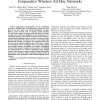Free Online Productivity Tools
i2Speak
i2Symbol
i2OCR
iTex2Img
iWeb2Print
iWeb2Shot
i2Type
iPdf2Split
iPdf2Merge
i2Bopomofo
i2Arabic
i2Style
i2Image
i2PDF
iLatex2Rtf
Sci2ools
INFOCOM
2010
IEEE
2010
IEEE
Cooperative Bridges: Topology Control in Cooperative Wireless Ad Hoc Networks
Cooperative Communication (CC) is a technology that allows multiple nodes to simultaneously transmit the same data. It can save power and extend transmission coverage. However, prior research work on topology control considers CC only in the aspect of energy saving, not that of coverage extension. We identify the challenges in the development of a centralized topology control scheme, named Cooperative Bridges, which reduces transmission power of nodes as well as increases network connectivity. We observe that CC can bridge (link) disconnected networks. We propose two algorithms that select the most energy efficient neighbor nodes, which assist a source to communicate with a destination node; an optimal method and a greedy heuristic. In addition, we consider a distributed version of the proposed topology control scheme. Our findings are substantiated by an extensive simulation study, through which we show that the Cooperative Bridges scheme substantially increases the connectivity while...
| Added | 13 Feb 2011 |
| Updated | 13 Feb 2011 |
| Type | Journal |
| Year | 2010 |
| Where | INFOCOM |
| Authors | Jieun Yu, Heejun Roh, Wonjun Lee, Sangheon Pack, Ding-Zhu Du |
Comments (0)

